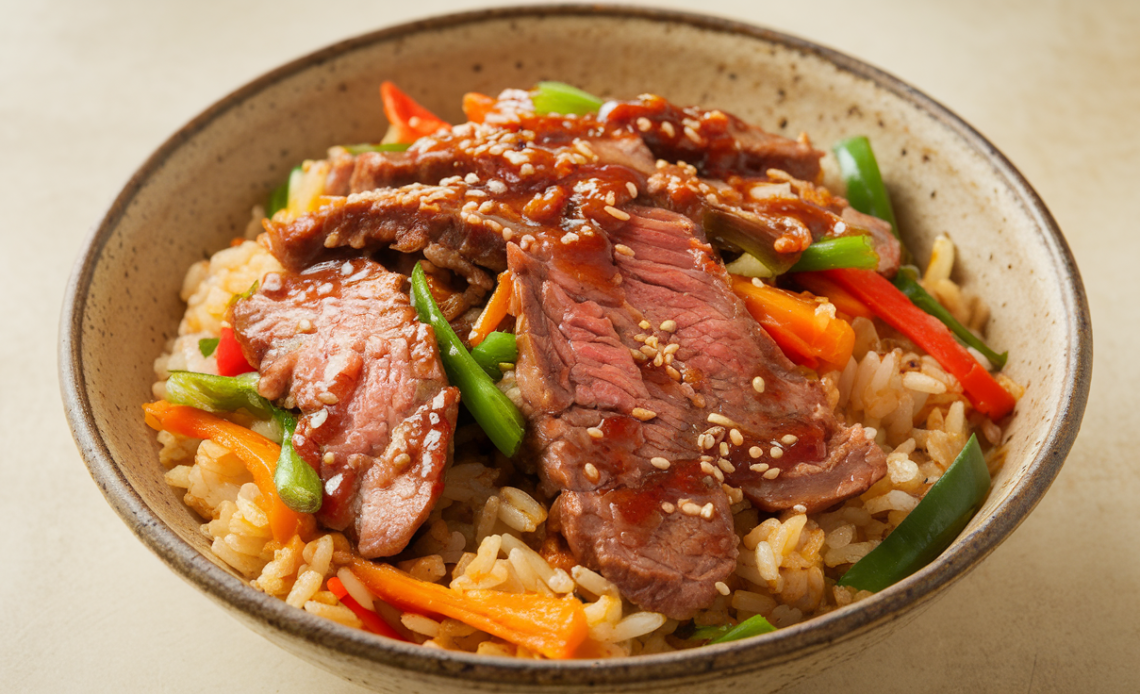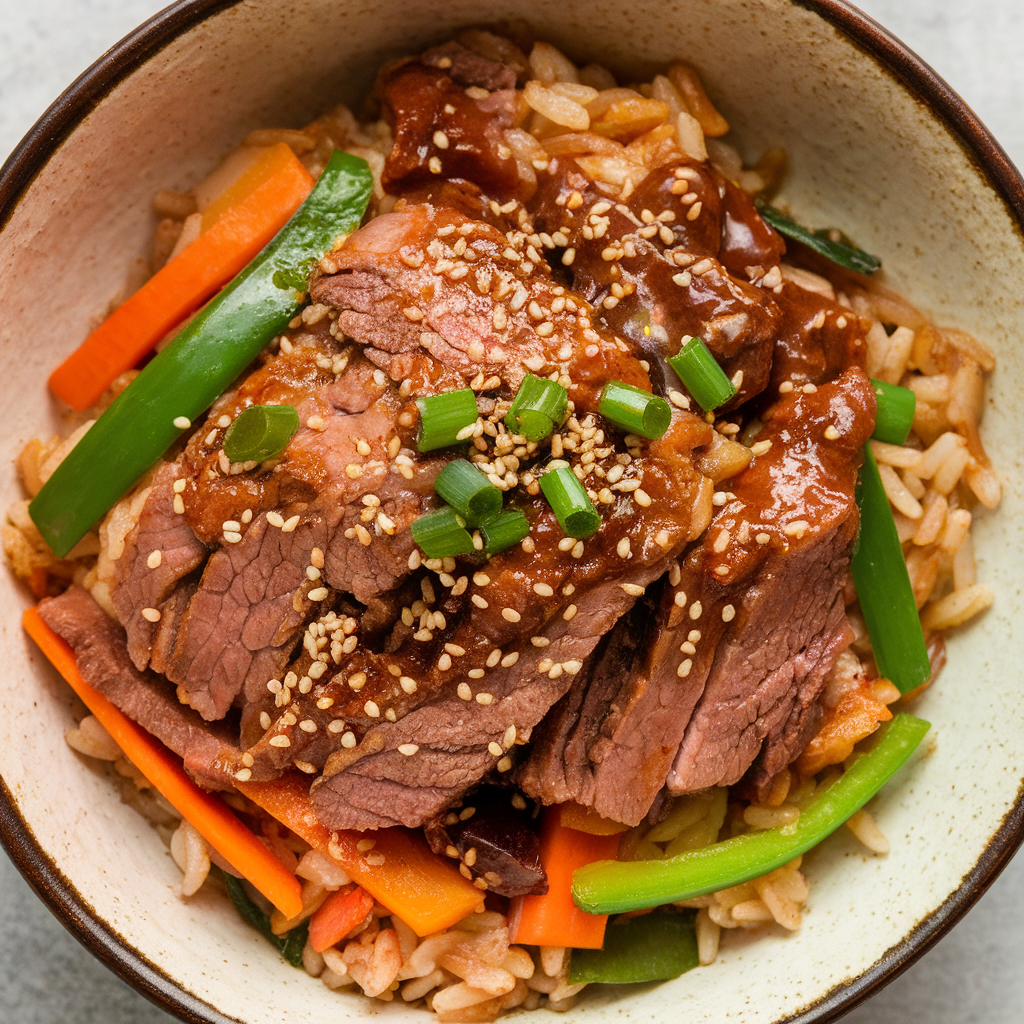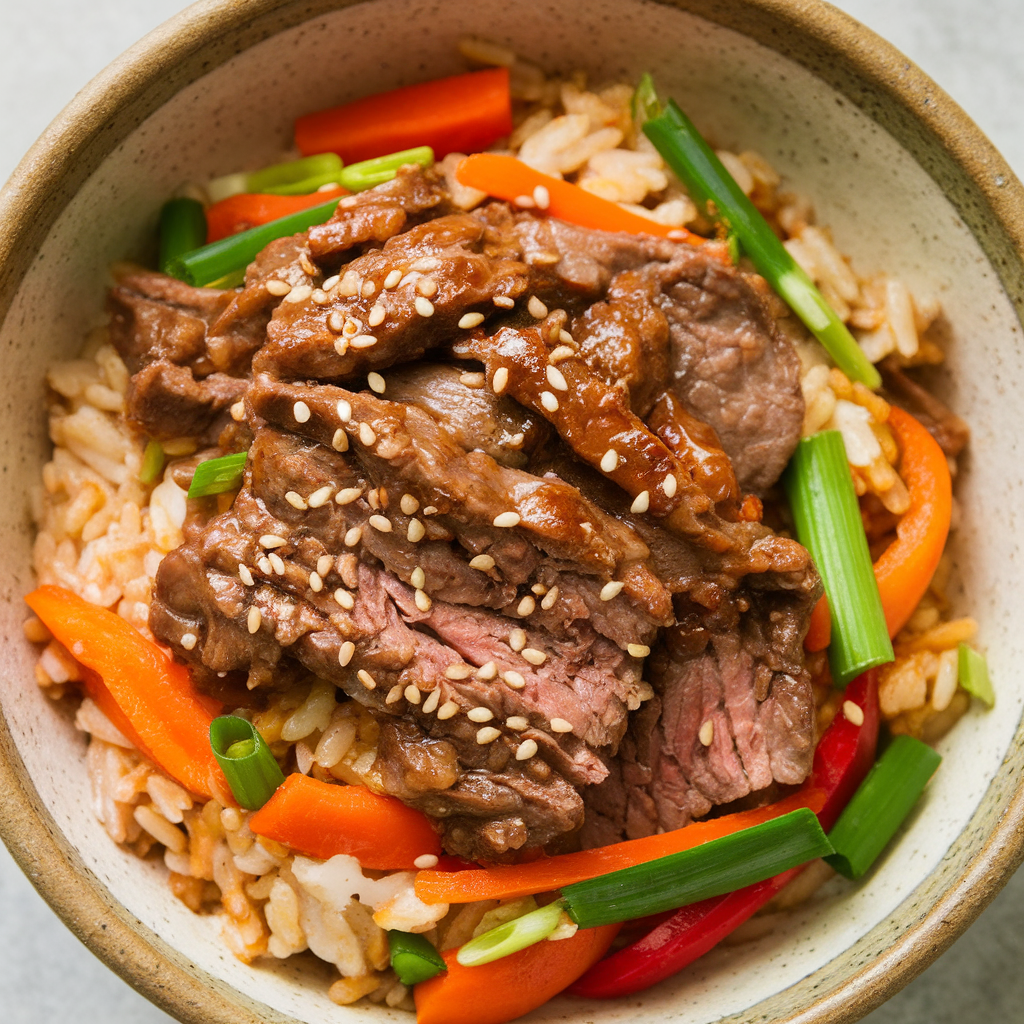
Fried rice is a timeless favorite across the globe — a dish that turns humble leftover rice into a delicious, hearty meal packed with flavor and texture. But when you combine the unmistakable sweet-savory notes of Korean bulgogi with the satisfying, quick-cook nature of fried rice, you get something truly spectacular: Bulgogi Fried Rice.
This recipe brilliantly marries the rich, caramelized essence of marinated beef with the familiar comfort of stir-fried rice. It’s a perfect way to enjoy the essence of Korean barbecue in a fast, one-pan meal that the whole family will love. Plus, it’s incredibly flexible — you can swap beef for chicken to create a delectable fried rice recipe chicken version, or add in kimchi for a punchy kimchi fried rice recipe twist.
Welcome to the cozy, heartfelt world of cottagecore cooking meets vibrant Korean street food — rustic, homemade, and deeply satisfying. In this article, we’ll guide you through the entire process of how to make fried rice with bulgogi beef, highlight the magic of crunchy crispy shallots, and share tips and variations to make this dish your new go-to.
Understanding Bulgogi: Korea’s “Fire Meat”
At the heart of this recipe lies bulgogi, one of Korea’s most iconic dishes. Bulgogi literally means “fire meat,” referring to the thinly sliced beef grilled over an open flame. But it’s more than just the cooking method — bulgogi is known for its sweet, savory, and umami-rich marinade made from soy sauce, sugar, garlic, sesame oil, and often pureed fruit like Asian pear or apple to tenderize the meat naturally.
This marinade transforms ordinary beef into tender, caramelized morsels packed with flavor. Bulgogi is traditionally cooked quickly over high heat, resulting in juicy, flavorful slices with a hint of char and sweetness.
Integrating bulgogi into fried rice allows you to enjoy the complexity of Korean barbecue in a fast, approachable dish that requires no grill and minimal cleanup.
Why Bulgogi Fried Rice?
You may be wondering: Why put bulgogi in fried rice when the original is typically served with rice on the side? The answer lies in the flavor fusion and practicality.
- One-pan meal: Combining bulgogi and fried rice creates a quick, filling dish that’s perfect for busy nights.
- Flavor depth: The marinade’s sweet and savory profile infuses every grain of rice for a richer taste than typical fried rice.
- Versatility: Use leftover rice, beef, or even kimchi from your fridge — reducing food waste.
- Textural contrast: Crispy vegetables and crunchy shallots balance the tender beef and fluffy rice.
- Family-friendly: Kids and adults alike appreciate the familiar fried rice with an exciting flavor twist.
Key Ingredients in Detail
Let’s explore the components that make this beef fried rice sing:
1. Beef Bulgogi
For the most authentic flavor, use thinly sliced ribeye or sirloin. Marinate it for at least 30 minutes, or overnight if possible. The marinade usually includes:
- Soy sauce: The salty umami base
- Brown sugar or honey: Adds caramelized sweetness
- Garlic and ginger: Aromatic essentials
- Sesame oil: For nutty depth
- Asian pear or apple juice: Natural tenderizer
- Mirin or rice wine: Adds subtle acidity and sweetness
The balance between sweet and salty in this marinade is what sets bulgogi apart.

2. Rice
Use leftover cold rice — ideally refrigerated overnight — because it’s drier and prevents the fried rice from becoming mushy. Jasmine or medium-grain rice works well. Freshly steamed rice can work but spread it out to cool first.
3. Kimchi
Kimchi is a staple in Korean cooking — fermented napa cabbage or radish spiced with chili, garlic, and ginger. Adding kimchi turns this into a delightful kimchi fried rice recipe alternative with a spicy, tangy kick.
4. Vegetables
Common choices include onions, carrots, bell peppers, and scallions. These add color, crunch, and nutrition. Feel free to customize with mushrooms, zucchini, or spinach for variety.
5. Eggs
Scrambled eggs add richness, moisture, and a soft texture that contrasts nicely with the beef and vegetables.
6. Aromatics and Seasonings
Garlic and ginger infuse the dish with warmth and depth. Soy sauce and sesame oil finish the fried rice with savory notes and a lovely fragrance.
7. Crispy Shallots
The crowning glory! Thinly sliced shallots fried until golden provide a crispy, sweet-savory crunch that elevates the dish. You can buy them pre-made or make your own at home.
The Perfect Bulgogi Marinade Recipe
Here’s a simple marinade recipe to get you started:
- 1/4 cup soy sauce
- 2 tablespoons brown sugar
- 1 tablespoon honey (optional for extra sweetness)
- 2 tablespoons grated Asian pear or apple
- 3 cloves garlic, minced
- 1 teaspoon grated ginger
- 1 tablespoon sesame oil
- 1 tablespoon mirin or rice wine (optional)
- Freshly ground black pepper to taste
Combine all ingredients, then toss thinly sliced beef in the mixture. Refrigerate for at least 30 minutes or overnight for best results.
Step-by-Step Cooking Instructions
Step 1: Marinate the Beef
Use high-quality beef and marinate as described above. This step is crucial for authentic bulgogi flavor and tender meat.
Step 2: Prepare Ingredients
Dice onions, carrots, bell peppers, and chop kimchi. Beat eggs in a small bowl and have all ingredients ready to go.
Step 3: Cook the Bulgogi Beef
Heat a wok or large skillet over high heat. Add a splash of vegetable oil and cook the marinated beef in batches to avoid overcrowding. Sear until caramelized and cooked through, about 3-5 minutes. Remove from pan and set aside.
Step 4: Stir-Fry Vegetables and Aromatics
In the same pan, add a bit more oil. Sauté garlic and ginger until fragrant, then add onions, carrots, and bell peppers. Stir-fry until softened but still slightly crisp.
Step 5: Add Rice and Kimchi
Add cold rice and chopped kimchi. Stir vigorously to separate clumps and combine. The kimchi provides spice and tanginess, complementing the sweet-salty beef.

Step 6: Scramble Eggs
Push rice mixture to one side of the pan. Pour beaten eggs into the cleared space and scramble until just set. Mix eggs into the rice.
Step 7: Combine Beef and Season
Return cooked bulgogi beef to the pan. Drizzle soy sauce and sesame oil over everything, stirring well to combine and heat through. Taste and adjust seasoning as needed.
Step 8: Add Crispy Shallots and Garnish
Transfer fried rice to plates and sprinkle generously with crispy shallots. Garnish with chopped scallions if desired for freshness and color.
Making Crispy Shallots at Home
If you’ve never made crispy shallots, they’re surprisingly easy and a fantastic addition to many dishes.
How to make crispy shallots:
- Thinly slice shallots using a mandoline or sharp knife.
- Heat vegetable oil in a small pan over medium heat.
- Fry shallot slices in batches, stirring frequently until golden brown.
- Remove with a slotted spoon and drain on paper towels.
- Let cool completely before storing in an airtight container.
Use these as a topping for your bulgogi fried rice to add crunch and a hint of sweetness.
Variations on Bulgogi Fried Rice
Chicken Bulgogi Fried Rice
Swap the beef for chicken bulgogi using the same marinade with thinly sliced chicken thighs or breasts. Chicken cooks faster and offers a lighter alternative while retaining the rich bulgogi flavors.
Vegetarian or Vegan Option
Replace meat with marinated tofu, tempeh, or mushrooms like shiitake or king oyster mushrooms. Use vegan soy sauce and omit eggs for a plant-based version.
Spicy Bulgogi Fried Rice
Add a tablespoon of gochujang (Korean chili paste) to the marinade or directly to the rice for a spicy kick. Adjust chili levels to taste.
Kimchi-Heavy Bulgogi Fried Rice
Increase kimchi quantity for a tangier, more fermented flavor profile, closer to a traditional kimchi fried rice recipe but with the sweet-salty beef background.
The Nutritional Benefits of Bulgogi Fried Rice
Bulgogi fried rice offers a balanced meal with:
- Protein: High-quality beef or chicken provides essential amino acids.
- Fiber & Vitamins: Vegetables and kimchi contribute fiber, vitamin C, and antioxidants.
- Probiotics: Fermented kimchi boosts gut health and digestion.
- Healthy Fats: Sesame oil contains beneficial fatty acids.
Portion control and vegetable addition can tailor this dish to fit various dietary goals.

The Art of Cottagecore Cooking in This Dish
The rising trend of cottagecore cooking embraces simplicity, sustainability, and homemade food with natural ingredients. Bulgogi fried rice fits perfectly into this ethos:
- Uses fresh, whole ingredients with minimal processing.
- Transforms leftovers (day-old rice, leftover kimchi) into new meals, reducing waste.
- Encourages making components from scratch (marinades, crispy shallots).
- Invokes a sense of comfort, tradition, and mindful cooking.
It’s a modern, cozy meal that celebrates heritage and seasonality, appealing to those seeking wholesome home cooking.
Common Questions About Bulgogi Fried Rice
Q: Can I use fresh rice?
A: Yes, but spread it on a tray and cool it first to reduce moisture. Cold, day-old rice works best to avoid mushiness.
Q: How spicy is this dish?
A: The bulgogi marinade itself is mild and sweet. Kimchi and gochujang add spice, so adjust based on your preference.
Q: What if I don’t have Asian pear?
A: You can substitute with apple or omit it. The meat will still be tender but the pear adds a subtle fruity sweetness.
Q: Can I freeze bulgogi fried rice?
A: Yes, but texture might slightly change. Reheat thoroughly and add fresh crispy shallots when serving for best results.
Serving and Pairing Suggestions
Bulgogi fried rice is a complete meal but pairs beautifully with:
- A simple cucumber salad dressed with rice vinegar for freshness.
- Miso soup or Korean seaweed soup for a warming starter.
- Extra kimchi or pickled radishes for tang and crunch.
- A fried egg on top for extra richness and protein.
How to Make Fried Rice Like a Pro
Here are some tips to get the best results when you make fried rice:
- Use a wok or large, heavy skillet for even heat and space to toss.
- High heat is essential for proper caramelization and “wok hei.”
- Don’t overcrowd the pan — cook in batches if needed.
- Use cold rice and break up clumps with your hands before cooking.
- Prep all ingredients beforehand as the cooking process is quick.
- Add eggs last for fluffy texture and avoid overcooking.
- Finish with a drizzle of toasted sesame oil for aroma.
Bringing It All Together: So Much Food, So Much Flavor
From the savory, caramelized bulgogi beef to the tangy, spicy kimchi and the satisfying, fluffy rice, this dish offers so much food with so much flavor in every bite. The addition of crispy shallots provides a delightful crunch that contrasts perfectly with the tender beef and vegetables.
Whether you’re a seasoned cook or trying your hand at Korean-inspired cooking for the first time, this bulgogi fried rice recipe is approachable, flavorful, and endlessly customizable.
So fire up your stove, gather your ingredients, and enjoy a delicious fusion of Korean barbecue and classic fried rice — right in your own kitchen.




